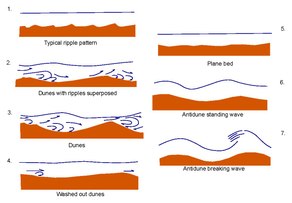User:Licks-rocks/sandbox/Giant current ripples


Giant current ripples, Giant gravel bars, Gravel dunes or GCR's[1], are a form of subaqueous dune. They are active channel topographic forms up to 20 m high, which occur within near-talweg areas of the main outflow routes created by glacial lake outburst floods. [2]. Giant current ripple marks are large scale analogues of small current ripples formed by sand in streams. Giant current ripple marks are important features associated with scablands. As a landscape component, they are found in several areas that were previously in the vicinity of large glacial lakes.[3]
Properties[edit]
Giant current ripples can reach a maximum height of 20 meters and reach a maximum length of 1 kilometer. they occur in ripple fields that can cover an area several kilometres across.[4][5] They consist mainly of gravel due to the high energy environment in which they were deposited.[5]. They are oriented with the long axis perpendicular to the flow direction. They are asymmetric in shape, with the steep flank oriented against the direction of flow. While they are often called ripples, their topography responds to hydraulic flow as well as boundary conditions, which means they are more accurately described as a type of dune.[6]

Scablands[edit]
Giant current ripples are a geomorphological phenomenon associated with scablands. Scablands form when lakes dammed off by glaciers suddenly burst through their dams and empty their contents in giant flooding events. They are found in the Altaj Mountains of russia,[4] as well as in the northwestern united states. Giant current ripples can reach a maximum height of twenty meters, and the ripples can cover an area several kilometres across.[4][5] Giant Current ripples formed under these conditions commonly consist mainly of gravel, as opposed to sand or silt, indicating the high energy environment in which they were deposited.[5][4]
Notable localities[edit]
North America[edit]

Giant current ripples are an important feature of the channeled scablands in Washington state, U.S. which formed during the Last Glacial Maximum as a result of more than 40 consecutive glacial lake bursts, called the Missoula floods, which originated from a glacial lake called lake missoula in current-day Montana.[7]
Altaj Mountains, Russia[edit]
Another area where Giant current ripples are an important landscape feature is In the Altai Mountains, Russia [3] At least seven major flooding events are believed to have happened in this area over a span of 150,000 years during Marine Isotope Stage 2, or the latter part of the last glaciation. The lakes that fed these events reached up to 600 km3 in capacity. Floodwater depths during the largest of these floods are estimated to have been 300 metres and the water would have been moving at a speed of 60 meters per second. This resulted in giant current ripple deposits of up to a hundred metres thick.[8]
Mars[edit]
American and British geologists and planetologists have discovered giant current ripple reliefs and other scabland features on Mars in the Cerberus plains, indicating that mega floods have occurred there at some point in the recent past.[9] While they have roughly the same dimensions as on earth when they occur, Giant current ripples appear to be much less common on mars relative to other scabland features, which is likely a result of differences in the availability of certain types of sediment.[6]
Distribution on Earth[edit]
Citations[edit]
- ^ Lewis, Reed S.; Schmidt, Keegan L. (2016-05-05). Exploring the Geology of the Inland Northwest. Geological Society of America. ISBN 978-0-8137-0041-0.
- ^ Singh, Indra Bir; Kumar, Surendra (1974-09-01). "Mega- and giant ripples in the Ganga, Yamuna, and Son Rivers, Uttar Pradesh, India". Sedimentary Geology. 12 (1): 53–66. doi:10.1016/0037-0738(74)90016-5. ISSN 0037-0738.
- ^ a b Rudoy, Alexei N (2002-01-01). "Glacier-dammed lakes and geological work of glacial superfloods in the Late Pleistocene, Southern Siberia, Altai Mountains". Quaternary International. Holocene Studies, INQUA Commission Meeting, Sevilla 2000. 87 (1): 119–140. doi:10.1016/S1040-6182(01)00066-0. ISSN 1040-6182.
- ^ a b c d Rudoy, Alexei N (2002-01-01). "Glacier-dammed lakes and geological work of glacial superfloods in the Late Pleistocene, Southern Siberia, Altai Mountains". Quaternary International. Holocene Studies, INQUA Commission Meeting, Sevilla 2000. 87 (1): 119–140. doi:10.1016/S1040-6182(01)00066-0. ISSN 1040-6182.
- ^ a b c d Lewis, Reed S.; Schmidt, Keegan L. (2016-05-05). Exploring the Geology of the Inland Northwest. Geological Society of America. ISBN 978-0-8137-0041-0.
- ^ a b Burr, Devon M.; Grier, Jennifer A.; McEwen, Alfred S.; Keszthelyi, Laszlo P. (2002-09). "Repeated Aqueous Flooding from the Cerberus Fossae: Evidence for Very Recently Extant, Deep Groundwater on Mars". Icarus. 159 (1): 53–73. doi:10.1006/icar.2002.6921.
{{cite journal}}: Check date values in:|date=(help) - ^ Medley, Erica (2000-01-01). "Ancient Cataclysmic Floods in the Pacific Northwest: Ancestors to the Missoula Floods".
{{cite journal}}: Cite journal requires|journal=(help) - ^ Carling, Paul A.; Martini, I. Peter; Herget, Jürgen; Borodavko, Pavel; Parnachov, Sergei (2009-09-24), "Megaflood sedimentary valley fill: Altai Mountains, Siberia", Megaflooding on Earth and Mars, Cambridge University Press, pp. 243–264, retrieved 2023-01-22
- ^ Megaflooding on Earth and Mars. Devon Burr, Victor R. Baker, Paul Carling. Cambridge, UK: Cambridge University Press. 2009. ISBN 978-0-511-63305-8. OCLC 667005201.
{{cite book}}: CS1 maint: others (link)

